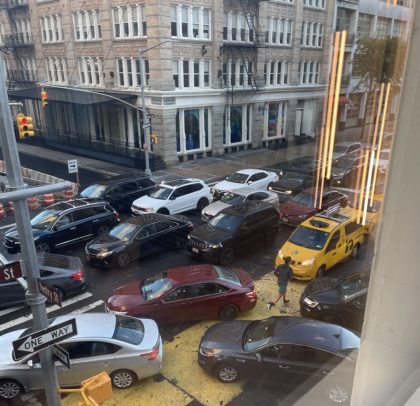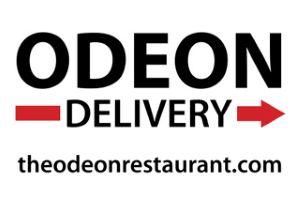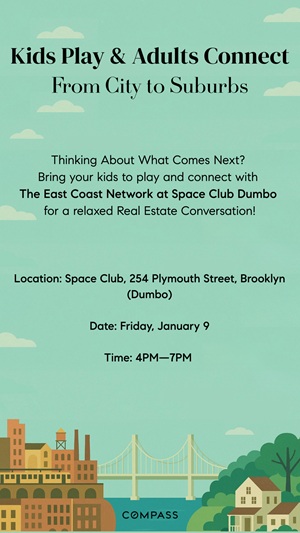CB1 Tonight: Solutions for pedestrians at the Holland Tunnel
CB1’s Transportation Committee will deal with the issue of the Holland Tunnel traffic at Vestry TONIGHT, so I am getting this post up quickly for that purpose so folks can join in. The meeting is online on WebEx here, starting at 6p.
Neighbors have gotten in touch with me in the past, most notably last November, when T. witnessed a baby stroller get hit by a car, and while no one was hurt, it was clearly alarming. He and he wife have had several near-misses on the corner of Vestry and Hudson. We’ve all seen it, but below are some videos for the record.
It makes sense that things are getting worse: the traffic consultant Sam Schwartz has predicted that an additional 85,000 cars will enter the Central Business District (CBD = south of 60th Street) in 2023 vs. 2019. See more on Schwartz’s study below.
Since T. wrote last fall, the Port Authority has installed lane dividers to keep drivers from sneaking in from local side streets, but the blocking of the box at Vestry continues to be an issue, T. said, especially on weekends and holidays when the traffic is at its worst and the NYPD and DOT do not seem to be present. (The Port Authority manages tunnel traffic on Hudson from 3 to 7p, Monday to Friday.)
Neighbors hope the city will permanently cut off access to the tunnel via Vestry Street as they do temporarily Monday to Friday. That is likely on the docket for tonight.
“Our neighbors that live on the east side of Vestry have shared that they access their homes coming up the local lane on the east side of Hudson which is much easier than navigating the gridlock at the intersection. The vast majority of the cars using the intersection is headed to the tunnel and not our neighborhood. Traffic cops should also be on Vestry, Laight, and maybe Hubert to control the traffic seven days a week during periods of congestion so families aren’t forced to take roundabout roots to cross the street.”
“With all these traffic injuries happening across the city, I’m surprised there isn’t more urgency to this issue.”
And I have taken the full text from Sam Schwartz’s survey and turned it into bullet points to give you a quick picture of traffic patterns between 2019 and post-pandemic:
- 2019: 73% of trips were on public transit
- 2021: 56% of trips are on transit
- Subways dropped from 56% to 39% (note: system-wide subway ridership has rebounded to over 50% of pre-pandemic volumes as of September 2021, but this survey only looked at subway trips into the CBD).
- 2023, transit is expected to bounce back to 65%, with subways projected to rebound to 48%
- People who switched from transit to driving are unlikely to fully switch back
- 2019: 23% of trips were by personal vehicle
- 2021: 35% during the pandemic
- 2023: car share is projected to reduce somewhat to 28% — still well above 2019 levels. This would translate to an increase of as many as 85,000 vehicles entering the CBD daily












We need actual enforcement of the laws against blocking pedestrian walkways, blocking the intersection, horn honking, reckless driving, red-light running, etc.
Dream on. NYPD proves daily they have zero interest in traffic-law enforcement.
Our best hope is to lower thru-traffic volumes, via congestion pricing. Tolling eastbound vehicle traffic on the Wmsburg, Manhattan & Bklyn Bridges will reroute a significant portion of LI-to-Jersey traffic to the Verrazzano, sparing lower Manhattan. More here: http://www.komanoff.net/cars_II/Why_downtown_should_back_congestion_pricing.php
I again urge my neighbors and our electeds who shudder at the thought of paying a toll to drive into and out of the Manhattan central business district to understand that the only way to drive a stake in the heart of gridlock is to charge every — no exceptions — car and truck trip that contributes to it.
People need to understand that if you want less of something (be it traffic, pollution, carbon, etc.), you need to charge/tax the people/activities creating the problem to change their decision making and price in the externality. It is not about raising money but changing behavior.
^^^what he said ^^^
I would have thought that the financial incentive would motivate the powers that be to write lots of tickets to the scofflaws.
Agree we need congestion pricing to reduce traffic, pollution, noise.
However, even with reduced congestion, traffic laws still must be properly enforced. What happened to “don’t block the box”?
After all, if the streets are less congested, that might mean even MORE dangerous and reckless driving, as seemed to happen during the relatively empty streets of the pandemic.
Maybe we need more automatic ticketing via cameras, for traffic violations and noise as well.
Here’s a proposed bill on noise-limit enforcement cameras. I would welcome this. The modified roaring engines, incessant horns, and apartment-shaking bass from car sound systems are not what I consider positives of the mythical “energy” of NYC.
Here’s some info on moves to enforce against loud engines at least, although does nothing about blasted music from vehicles, or against the gratuitous horn-honking:
https://www.thecity.nyc/2022/2/24/22949795/new-york-rolling-out-noise-law-listening-tech-for-souped-up-speedsters
I agree with you, Marcus. There seems to be very little to no enforcement; why would people otherwise continue with their illegal turns, blocking the box, incessant honking, speeding, fart cars producing noise above the legal limit, etc. etc? True enforcement, congestion charging and paid parking should help. Why have precious Manhattan real estate clogged with polluting cars, SUVs and trucks with usually only one person in them?
PS Submitting complaints via 311 also seems like a waste of time.
Agreed 311 seems to go nowhere (maybe it adds to the total count of complaints and somewhere down the line matters in prioritizing issues to be addressed… or maybe they are just ignored).
What are better ways to actually get some real change to occur?
Critical that this issue gets addressed. Watts also has a similar traffic pattern with tunnel traffic tying up quiet, local, residential streets in an attempt to save maybe a couple of seconds. Blocking the box, running reds, and illegal turns need to be strictly enforced. I’ve seen tons of cars make rights from Hubert and Vestry and go the wrong way against traffic down Hudson because they get trapped. Cars need to be forced to enter the tunnel via Canal from the WSH or up Hudson. No thru-traffic on local side streets.
It’s about time! Think closing Vestry so it can’t be used to access the tunnel will have an enormous impact on improving safety in our community and finally stopping the insane congestion that builds at the Hudson/Vestry intersection. This is a neighborhood filled with young children not a highway and the aggressive dangerous driver behavior has to be stopped. Thrilled that the safety of children and pedestrians is finally being prioritized over drivers.
Tunnel traffic backs up as far as White and Church and has done so for decades with no enforcement whatsoever. Further, the crosswalks are blocked when the light is red, yellow or green. Cars are packed tightly together as peds weave their way through the intersection any way they can while drivers yell and honk at them.
Again – (except for during Quarantine) it’s been this way for decades.
Aren’t there private companies that provide crossing guards? There’s a team of them on Varick St. They help the traffic move along and keep the crosswalks clear.
BTW, those lane dividers on Hudson Street create a hazard to bikers (like me) who are now forced to share a single lane (as cars or trucks are usually parked in the left lane) heading up Hudson until you can access the bike lane north of Hudson. Previously cars *could* swing right to give you wide berth when passing, but no longer. Only matter of time until a bike rider is injured by a passing vehicle.
We’ve lived down here for almost years and what at one time was “a weekend thing” is now “a daily thing.” Yes, there are usually one or two traffic cops down at the corner of Canal and Hudson, but the damage has been done long before that. Every intersection along Hudson, all the way back to Jay St. (and sometimes beyond) is a mess because drivers will do whatever possible to gain that extra inch or two, trying to prevent another vehicle from possibly getting in front of them. Trying to cross Hudson while driving on any side street requires sitting through at least five or six green lights. Don’t Block The Box? You can’t even see the boxes any longer. Congestion pricing and other possible fixes that hit drivers in their wallets will eventually help (a bit), but an immediate bandaid (and I think we’d all settle for one of those right now) would be to position more traffic enforcement officers along Hudson St. to keep the intersections clear. I know that’s easier said than done because the next question becomes, “Who pays for them?” but as local residents, that shouldn’t fall on our shoulders.
Happens on Spring st. as well. In fact DOT shuts access Northbound on West St. onto Canal and directs them to Spring for some reason. Honestly, there is no solution except congestion pricing. Everything else is like a finger in the dike, another leak appears.
Presumably the city could make $thousands in tickets on a daily basis from violations around the tunnel entrance: red-light running, blocking intersection, horn honking, endangering pedestrians, etc. Why no enforcement?
There is a reality that you cannot manage around traffic, unless you can reduce it or get rid of it. i.e. less people in cars. Congestion pricing is one tool. Cars, and esp with apps like Waze, just fill in the voids. There are really no examples anywhere of making traffic better unless you take a road away or reduce car trips. This problem isnt going away. Perhaps congestion pricing will help
I disagree. I saw a whole team of people that looked like traffic agents, but I asked and they were a private company. They were on 6 intersections north of holland tunnel, moving traffic along better and keeping crosswalks clear. Might be a temporary fix but at least it’s something. Didn’t get company name unfortunately but they work for Hudson sq. Next time, I will ask
Full disclosure–I’m a driver. And I believe congestion pricing to be a good idea for generating revenue for mass-transit, but it will not help significantly address this problem. And the block-the-box ignorance radiates outward to all the Holland Tunnel’s approaches. For whatever reasons, there’s been almost a “tradition” of drivers blocking intersections in order to creep a few feet forward. It’s just what’s done, as senseless as it is. If there were some electronic means of enforcement–is there?–compliance would be immediate!
I asked one of 20 cops on the sidewalk if he could ask a tour bus parked illegally to cut his engine and move. He said it wouldn’t make a difference and that the only way to direct traffic ticket enforcement would be to log complaints on the 311 app. Maybe if there was a week that as many people as possible could log complaints multiple times of the day, the 1st precinct might assign someone to enforce those laws.
Actually idling trucks and buses *can* be fined — and there is a new citizen complaint form that gives citizens a cut. Don’t use 311; use the DEP website directly. The rules are no more than three minutes in general; one minute in front of a school. You have to observe the vehicle and time it, and provide evidence with video. There are exceptions, such as ice cream trucks that need their engine to run the business. See more about it here:
https://www1.nyc.gov/site/dep/environment/idling-citizens-air-complaint-program.page